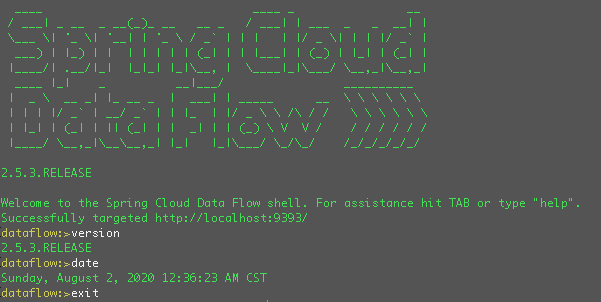1 前言
之前我们用两篇文章讲解了Spring Cloud Data Flow,例子都是用UI操作的,但我们在Linux系统上经常是无法提供界面来操作,集成在Jenkins上也无法使用UI。好在官方提供了Data Flow Shell工具,可以在命令行模式下进行操作,非常方便。
相关文章可参考:
Spring Cloud Data Flow初体验,以Local模式运行
把Spring Cloud Data Flow部署在Kubernetes上,再跑个任务试试
Spring Cloud Data Flow Server提供了可操作的REST API,所以这个Shell工具的本质还是通过调用REST API来交互的。
2 常用操作
2.1 启动
首先要确保我们已经安装有Java环境和下载了可执行的jar包:spring-cloud-dataflow-shell-2.5.3.RELEASE.jar
然后启动如下:
$ java -jar spring-cloud-dataflow-shell-2.5.3.RELEASE.jar

默认是连接了http://localhost:9393的Server,可以通过--dataflow.uri=地址来指定。如果需要认证信息,需要加上--dataflow.username=用户 --dataflow.password=密码。
比如我们连接之前安装在Kubernetes上的Server如下:
$ java -jar spring-cloud-dataflow-shell-2.5.3.RELEASE.jar --dataflow.uri=http://localhost:30093
2.2 Application操作
介绍一下Application相关操作:
列出所有目前注册的app:
dataflow:>app list
╔═══╤══════╤═════════╤════╤════════════════════╗
║app│source│processor│sink│ task ║
╠═══╪══════╪═════════╪════╪════════════════════╣
║ │ │ │ │composed-task-runner║
║ │ │ │ │timestamp-batch ║
║ │ │ │ │timestamp ║
╚═══╧══════╧═════════╧════╧════════════════════╝
查看某个app的信息:
dataflow:>app info --type task timestamp
Information about task application 'timestamp':
Version: '2.1.1.RELEASE':
Default application version: 'true':
Resource URI: docker:springcloudtask/timestamp-task:2.1.1.RELEASE
╔══════════════════════════════╤══════════════════════════════╤══════════════════════════════╤══════════════════════════════╗
║ Option Name │ Description │ Default │ Type ║
╠══════════════════════════════╪══════════════════════════════╪══════════════════════════════╪══════════════════════════════╣
║timestamp.format │The timestamp format, │yyyy-MM-dd HH:mm:ss.SSS │java.lang.String ║
║ │"yyyy-MM-dd HH:mm:ss.SSS" by │ │ ║
║ │default. │ │ ║
╚══════════════════════════════╧══════════════════════════════╧══════════════════════════════╧══════════════════════════════╝
清除app注册信息:
dataflow:>app unregister --type task timestamp
Successfully unregistered application 'timestamp' with type 'task'.
dataflow:>app list
╔═══╤══════╤═════════╤════╤════════════════════╗
║app│source│processor│sink│ task ║
╠═══╪══════╪═════════╪════╪════════════════════╣
║ │ │ │ │composed-task-runner║
║ │ │ │ │timestamp-batch ║
╚═══╧══════╧═════════╧════╧════════════════════╝
清除所有app注册信息:
dataflow:>app all unregister
Successfully unregistered applications.
dataflow:>app list
No registered apps.
You can register new apps with the 'app register' and 'app import' commands.
注册一个app:
dataflow:>app register --name timestamp-pkslow --type task --uri docker:springcloudtask/timestamp-task:2.1.1.RELEASE
Successfully registered application 'task:timestamp-pkslow'
dataflow:>app list
╔═══╤══════╤═════════╤════╤════════════════╗
║app│source│processor│sink│ task ║
╠═══╪══════╪═════════╪════╪════════════════╣
║ │ │ │ │timestamp-pkslow║
╚═══╧══════╧═════════╧════╧════════════════╝
批量导入app,可以从一个URL或一个properties文件导入:
dataflow:>app import https://dataflow.spring.io/task-docker-latest
Successfully registered 3 applications from [task.composed-task-runner, task.timestamp.metadata, task.composed-task-runner.metadata, task.timestamp-batch.metadata, task.timestamp-batch, task.timestamp]
dataflow:>app list
╔═══╤══════╤═════════╤════╤════════════════════╗
║app│source│processor│sink│ task ║
╠═══╪══════╪═════════╪════╪════════════════════╣
║ │ │ │ │timestamp-pkslow ║
║ │ │ │ │composed-task-runner║
║ │ │ │ │timestamp-batch ║
║ │ │ │ │timestamp ║
╚═══╧══════╧═════════╧════╧════════════════════╝
需要注意的是,在注册或导入app时,如果重复的话,默认是无法导入的,不会覆盖。如果想要覆盖,可以加参数--force。
dataflow:>app register --name timestamp-pkslow --type task --uri docker:springcloudtask/timestamp-task:2.1.1.RELEASE
Command failed org.springframework.cloud.dataflow.rest.client.DataFlowClientException: The 'task:timestamp-pkslow' application is already registered as docker:springcloudtask/timestamp-task:2.1.1.RELEASE
The 'task:timestamp-pkslow' application is already registered as docker:springcloudtask/timestamp-task:2.1.1.RELEASE
dataflow:>app register --name timestamp-pkslow --type task --uri docker:springcloudtask/timestamp-task:2.1.1.RELEASE --force
Successfully registered application 'task:timestamp-pkslow'
2.3 Task操作
列出task:
dataflow:>task list
╔════════════════╤════════════════════════════════╤═══════════╤═══════════╗
║ Task Name │ Task Definition │description│Task Status║
╠════════════════╪════════════════════════════════╪═══════════╪═══════════╣
║timestamp-pkslow│timestamp │ │COMPLETE ║
║timestamp-two │<t1: timestamp || t2: timestamp>│ │ERROR ║
║timestamp-two-t1│timestamp │ │COMPLETE ║
║timestamp-two-t2│timestamp │ │COMPLETE ║
╚════════════════╧════════════════════════════════╧═══════════╧═══════════╝
删除一个task,这里我们删除的是一个组合task,所以会把子task也一并删除了:
dataflow:>task destroy timestamp-two
Destroyed task 'timestamp-two'
dataflow:>task list
╔════════════════╤═══════════════╤═══════════╤═══════════╗
║ Task Name │Task Definition│description│Task Status║
╠════════════════╪═══════════════╪═══════════╪═══════════╣
║timestamp-pkslow│timestamp │ │COMPLETE ║
╚════════════════╧═══════════════╧═══════════╧═══════════╝
删除所有task,会有风险提示:
dataflow:>task all destroy
Really destroy all tasks? [y, n]: y
All tasks destroyed
dataflow:>task list
╔═════════╤═══════════════╤═══════════╤═══════════╗
║Task Name│Task Definition│description│Task Status║
╚═════════╧═══════════════╧═══════════╧═══════════╝
创建一个task:
dataflow:>task create timestamp-pkslow-t1 --definition "timestamp --format=\"yyyy\"" --description "pkslow timestamp task"
Created new task 'timestamp-pkslow-t1'
dataflow:>task list
╔═══════════════════╤═══════════════════════╤═════════════════════╤═══════════╗
║ Task Name │ Task Definition │ description │Task Status║
╠═══════════════════╪═══════════════════════╪═════════════════════╪═══════════╣
║timestamp-pkslow-t1│timestamp --format=yyyy│pkslow timestamp task│UNKNOWN ║
╚═══════════════════╧═══════════════════════╧═════════════════════╧═══════════╝
启动一个task并查看状态,启动时需要记录执行ID,然后通过执行ID来查询状态:
dataflow:>task launch timestamp-pkslow-t1
Launched task 'timestamp-pkslow-t1' with execution id 8
dataflow:>task execution status 8
╔═══════════════╤═══════════════════════════════════════════════════════════════════════════════════════════════════════════════════════════════════════════════════════════════════════════════╗
║ Key │ Value ║
╠═══════════════╪═══════════════════════════════════════════════════════════════════════════════════════════════════════════════════════════════════════════════════════════════════════════════╣
║Id │8 ║
║Resource URL │Docker Resource [docker:springcloudtask/timestamp-task:2.1.1.RELEASE] ║
║Name │timestamp-pkslow-t1 ║
║CLI Arguments │[--timestamp.format=yyyy, --spring.datasource.username=******, --spring.datasource.url=******, --spring.datasource.driverClassName=org.mariadb.jdbc.Driver, ║
║ │--spring.cloud.task.name=timestamp-pkslow-t1, --spring.datasource.password=******, --spring.cloud.data.flow.platformname=default, --spring.cloud.task.executionid=8] ║
║App Arguments │ timestamp.format = yyyy ║
║ │ spring.datasource.username = ****** ║
║ │ spring.datasource.url = ****** ║
║ │spring.datasource.driverClassName = org.mariadb.jdbc.Driver ║
║ │ spring.cloud.task.name = timestamp-pkslow-t1 ║
║ │ spring.datasource.password = ****** ║
║Deployment │ ║
║Properties │ ║
║Job Execution │[] ║
║Ids │ ║
║Start Time │Sun Aug 02 01:20:52 CST 2020 ║
║End Time │Sun Aug 02 01:20:52 CST 2020 ║
║Exit Code │0 ║
║Exit Message │ ║
║Error Message │ ║
║External │timestamp-pkslow-t1-r27jvm6591 ║
║Execution Id │ ║
╚═══════════════╧═══════════════════════════════════════════════════════════════════════════════════════════════════════════════════════════════════════════════════════════════════════════════╝
查看所有task执行并查看执行日志:
dataflow:>task execution list
╔═══════════════════╤══╤════════════════════════════╤════════════════════════════╤═════════╗
║ Task Name │ID│ Start Time │ End Time │Exit Code║
╠═══════════════════╪══╪════════════════════════════╪════════════════════════════╪═════════╣
║timestamp-pkslow-t1│8 │Sun Aug 02 01:20:52 CST 2020│Sun Aug 02 01:20:52 CST 2020│0 ║
║timestamp-two-t2 │7 │Sat Aug 01 00:46:34 CST 2020│Sat Aug 01 00:46:35 CST 2020│0 ║
║timestamp-two-t1 │6 │Sat Aug 01 00:46:28 CST 2020│Sat Aug 01 00:46:28 CST 2020│0 ║
║timestamp-two │5 │Sat Aug 01 00:46:22 CST 2020│Sat Aug 01 00:46:23 CST 2020│1 ║
║timestamp-two │4 │Sat Aug 01 00:45:45 CST 2020│Sat Aug 01 00:46:37 CST 2020│0 ║
║timestamp-pkslow │3 │Wed Jul 29 16:57:19 CST 2020│Wed Jul 29 16:57:19 CST 2020│0 ║
║timestamp │2 │Wed Jul 29 15:41:40 CST 2020│Wed Jul 29 15:41:40 CST 2020│0 ║
║timestamp │1 │ │ │ ║
╚═══════════════════╧══╧════════════════════════════╧════════════════════════════╧═════════╝
dataflow:>task execution log 8
2020-08-01 17:20:48.967 INFO 1 --- [ main] trationDelegate$BeanPostProcessorChecker : Bean 'org.springframework.cloud.autoconfigure.ConfigurationPropertiesRebinderAutoConfiguration' of type [org.springframework.cloud.autoconfigure.ConfigurationPropertiesRebinderAutoConfiguration$$EnhancerBySpringCGLIB$$ccb7e6d0] is not eligible for getting processed by all BeanPostProcessors (for example: not eligible for auto-proxying)
. ____ _ __ _ _
/\\ / ___'_ __ _ _(_)_ __ __ _ \ \ \ \
( ( )\___ | '_ | '_| | '_ \/ _` | \ \ \ \
\\/ ___)| |_)| | | | | || (_| | ) ) ) )
' |____| .__|_| |_|_| |_\__, | / / / /
=========|_|==============|___/=/_/_/_/
:: Spring Boot :: (v2.1.13.RELEASE)
2020-08-01 17:20:49.200 INFO 1 --- [ main] c.c.c.ConfigServicePropertySourceLocator : Fetching config from server at : http://localhost:8888
2020-08-01 17:20:49.411 INFO 1 --- [ main] c.c.c.ConfigServicePropertySourceLocator : Connect Timeout Exception on Url - http://localhost:8888. Will be trying the next url if available
2020-08-01 17:20:49.411 WARN 1 --- [ main] c.c.c.ConfigServicePropertySourceLocator : Could not locate PropertySource: I/O error on GET request for "http://localhost:8888/timestamp-task/default": Connection refused (Connection refused); nested exception is java.net.ConnectException: Connection refused (Connection refused)
2020-08-01 17:20:49.415 INFO 1 --- [ main] o.s.c.t.a.t.TimestampTaskApplication : No active profile set, falling back to default profiles: default
2020-08-01 17:20:50.059 INFO 1 --- [ main] o.s.cloud.context.scope.GenericScope : BeanFactory id=206f72b7-a955-301c-9338-4db66c6fe95b
2020-08-01 17:20:50.130 INFO 1 --- [ main] trationDelegate$BeanPostProcessorChecker : Bean 'org.springframework.cloud.autoconfigure.ConfigurationPropertiesRebinderAutoConfiguration' of type [org.springframework.cloud.autoconfigure.ConfigurationPropertiesRebinderAutoConfiguration$$EnhancerBySpringCGLIB$$ccb7e6d0] is not eligible for getting processed by all BeanPostProcessors (for example: not eligible for auto-proxying)
2020-08-01 17:20:50.479 INFO 1 --- [ main] com.zaxxer.hikari.HikariDataSource : HikariPool-1 - Starting...
2020-08-01 17:20:50.663 INFO 1 --- [ main] com.zaxxer.hikari.HikariDataSource : HikariPool-1 - Start completed.
2020-08-01 17:20:51.602 INFO 1 --- [ main] o.s.c.t.a.t.TimestampTaskApplication : Started TimestampTaskApplication in 3.98 seconds (JVM running for 4.782)
2020-08-01 17:20:51.604 INFO 1 --- [ main] TimestampTaskConfiguration$TimestampTask : 2020
2020-08-01 17:20:51.626 INFO 1 --- [ Thread-5] com.zaxxer.hikari.HikariDataSource : HikariPool-1 - Shutdown initiated...
2020-08-01 17:20:51.633 INFO 1 --- [ Thread-5] com.zaxxer.hikari.HikariDataSource : HikariPool-1 - Shutdown completed.
2.4 Http请求
可以进行http请求:
dataflow:>http get https://www.pkslow.com
dataflow:>http post --target https://www.pkslow.com --data "data"
> POST (text/plain) https://www.pkslow.com data
> 405 METHOD_NOT_ALLOWED
Error sending data 'data' to 'https://www.pkslow.com'
2.5 读取并执行文件
先准备一个脚本文件,用来放Data Flow Shell命令,文件名为pkslow.shell,内容如下:
version
date
app list
执行与结果如下:
dataflow:>script pkslow.shell
version
2.5.3.RELEASE
date
Sunday, August 2, 2020 1:59:34 AM CST
app list
╔═══╤══════╤═════════╤════╤════════════════════╗
║app│source│processor│sink│ task ║
╠═══╪══════╪═════════╪════╪════════════════════╣
║ │ │ │ │timestamp-pkslow ║
║ │ │ │ │composed-task-runner║
║ │ │ │ │timestamp-batch ║
║ │ │ │ │timestamp ║
╚═══╧══════╧═════════╧════╧════════════════════╝
Script required 0.045 seconds to execute
dataflow:>
但其实我们在CI/CD的pipeline中,并不想先启动一个shell命令行,然后再执行一个脚本。我们想一步到位,直接执行,执行完毕后退出shell命令行。这也是有办法的,可以在启动的时候通过--spring.shell.commandFile指定文件,如果有多个文件则用逗号,分隔。如下所示:
$ java -jar spring-cloud-dataflow-shell-2.5.3.RELEASE.jar --dataflow.uri=http://localhost:30093 --spring.shell.commandFile=pkslow.shell
Successfully targeted http://localhost:30093
2020-08-02T02:03:49+0800 INFO main o.s.c.d.s.DataflowJLineShellComponent:311 - 2.5.3.RELEASE
2020-08-02T02:03:49+0800 INFO main o.s.c.d.s.DataflowJLineShellComponent:311 - Sunday, August 2, 2020 2:03:49 AM CST
2020-08-02T02:03:49+0800 INFO main o.s.c.d.s.DataflowJLineShellComponent:309 -
╔═══╤══════╤═════════╤════╤════════════════════╗
║app│source│processor│sink│ task ║
╠═══╪══════╪═════════╪════╪════════════════════╣
║ │ │ │ │timestamp-pkslow ║
║ │ │ │ │composed-task-runner║
║ │ │ │ │timestamp-batch ║
║ │ │ │ │timestamp ║
╚═══╧══════╧═════════╧════╧════════════════════╝
$
执行完毕后,不会在shell命令行模式里,而是退回linux的终端。这正是我们所需要的。
我们来准备一个注册应用——创建任务——执行任务的脚本试试:
version
date
app register --name pkslow-app-1 --type task --uri docker:springcloudtask/timestamp-task:2.1.1.RELEASE
task create pkslow-task-1 --definition "pkslow-app-1"
task launch pkslow-task-1
执行与结果如下:
$ java -jar spring-cloud-dataflow-shell-2.5.3.RELEASE.jar --dataflow.uri=http://localhost:30093 --spring.shell.commandFile=pkslow.shell
Successfully targeted http://localhost:30093
2020-08-02T02:06:41+0800 INFO main o.s.c.d.s.DataflowJLineShellComponent:311 - 2.5.3.RELEASE
2020-08-02T02:06:41+0800 INFO main o.s.c.d.s.DataflowJLineShellComponent:311 - Sunday, August 2, 2020 2:06:41 AM CST
2020-08-02T02:06:41+0800 INFO main o.s.c.d.s.DataflowJLineShellComponent:311 - Successfully registered application 'task:pkslow-app-1'
2020-08-02T02:06:42+0800 INFO main o.s.c.d.s.DataflowJLineShellComponent:311 - Created new task 'pkslow-task-1'
2020-08-02T02:06:51+0800 INFO main o.s.c.d.s.DataflowJLineShellComponent:311 - Launched task 'pkslow-task-1' with execution id 9
这样,我们就可以实现自动化打包与部署运行了。
3 一些使用技巧
强大的shell工具提供了许多命令,其实不用一一记住,可以通过help命令查看所有命令:
dataflow:>help
* ! - Allows execution of operating system (OS) commands
* // - Inline comment markers (start of line only)
* ; - Inline comment markers (start of line only)
* app all unregister - Unregister all applications
* app default - Change the default application version
* app import - Register all applications listed in a properties file
* app info - Get information about an application
* app list - List all registered applications
* app register - Register a new application
* app unregister - Unregister an application
* clear - Clears the console
* cls - Clears the console
* dataflow config info - Show the Dataflow server being used
* dataflow config server - Configure the Spring Cloud Data Flow REST server to use
* date - Displays the local date and time
* exit - Exits the shell
* help - List all commands usage
* http get - Make GET request to http endpoint
* http post - POST data to http endpoint
* job execution display - Display the details of a specific job execution
* job execution list - List created job executions filtered by jobName
* job execution restart - Restart a failed job by jobExecutionId
* job execution step display - Display the details of a specific step execution
* job execution step list - List step executions filtered by jobExecutionId
* job execution step progress - Display the details of a specific step progress
* job instance display - Display the job executions for a specific job instance.
* quit - Exits the shell
* runtime apps - List runtime apps
* script - Parses the specified resource file and executes its commands
* stream all destroy - Destroy all existing streams
* stream all undeploy - Un-deploy all previously deployed stream
* stream create - Create a new stream definition
* stream deploy - Deploy a previously created stream using Skipper
* stream destroy - Destroy an existing stream
* stream history - Get history for the stream deployed using Skipper
* stream info - Show information about a specific stream
* stream list - List created streams
* stream manifest - Get manifest for the stream deployed using Skipper
* stream platform-list - List Skipper platforms
* stream rollback - Rollback a stream using Skipper
* stream scale app instances - Scale app instances in a stream
* stream undeploy - Un-deploy a previously deployed stream
* stream update - Update a previously created stream using Skipper
* stream validate - Verify that apps contained in the stream are valid.
* system properties - Shows the shell's properties
* task all destroy - Destroy all existing tasks
* task create - Create a new task definition
* task destroy - Destroy an existing task
* task execution cleanup - Clean up any platform specific resources linked to a task execution
* task execution current - Display count of currently executin tasks and related information
* task execution list - List created task executions filtered by taskName
* task execution log - Retrieve task execution log
* task execution status - Display the details of a specific task execution
* task execution stop - Stop executing tasks
* task launch - Launch a previously created task
* task list - List created tasks
* task platform-list - List platform accounts for tasks
* task schedule create - Create new task schedule
* task schedule destroy - Delete task schedule
* task schedule list - List task schedules by task definition name
* task validate - Validate apps contained in task definitions
* version - Displays shell version
如果只对特定的一类命令感兴趣,可以通过help xxx的方式获取帮助:
dataflow:>help version
* version - Displays shell version
dataflow:>help app
* app all unregister - Unregister all applications
* app default - Change the default application version
* app import - Register all applications listed in a properties file
* app info - Get information about an application
* app list - List all registered applications
* app register - Register a new application
* app unregister - Unregister an application
shell还支持tab键补全命令。
4 总结
本文的命令比较多,执行结果也贴出来了。这样能加深理解。
